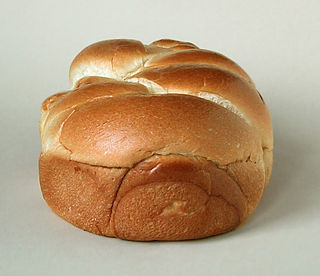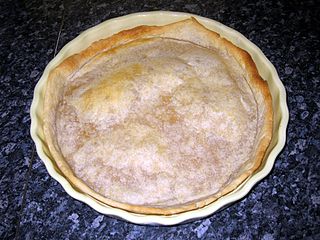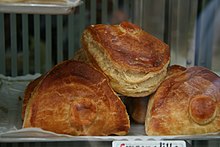
Shortcrust is a type of pastry often used for the base of a tart, quiche, pie, or flan. Shortcrust pastry can be used to make both sweet and savory pies such as apple pie, quiche, lemon meringue or chicken pie.

Pastry refers to a variety of doughs, as well as the sweet and savoury baked goods made from them. The dough may be accordingly called pastry dough for clarity. Sweetened pastries are often described as bakers' confectionery. Common pastry dishes include pies, tarts, quiches, croissants, and pasties.

A croissant is a French pastry in a crescent shape made from a laminated yeast dough similar to puff pastry.

A Danish pastry is a multilayered, laminated sweet pastry in the viennoiserie tradition. It is thought that some bakery techniques were brought to Denmark by Austrian bakers, and originated the name of this pastry. The Danish recipe is however different from the Viennese one and has since developed into a Danish specialty.

Brioche is a pastry of French origin whose high egg and butter content gives it a rich and tender crumb. The chef Joël Robuchon described it as "light and slightly puffy, more or less fine, according to the proportion of butter and eggs". It has a dark, golden, and flaky crust, frequently accentuated by an egg wash applied after proofing.

Beignet is a type of deep-fried pastry of French origin. It is commonly made from pâte à choux, but can also be made using rice flour or yeast-leavened batters. Beignets can be served in a variety of preparations, the most common being dusted with confectioner’s sugar. The pastry is popular in French, Italian, and American cuisines.

Dough is a malleable, sometimes elastic paste made from grains or from leguminous or chestnut crops. Dough is typically made by mixing flour with a small amount of water or other liquid and sometimes includes yeast or other leavening agents, as well as ingredients such as fats or flavourings.

The tarte Tatin, named after the Tatin sisters who invented it and served it in their hotel as its signature dish, is a pastry in which the fruit is caramelized in butter and sugar before the tart is baked. It originated in France but has spread to other countries over the years.

A profiterole, chou à la crème, also known alternatively as a cream puff (US), is a filled French choux pastry ball with a typically sweet and moist filling of whipped cream, custard, pastry cream, or ice cream. The puffs may be embellished or left plain or garnished with chocolate sauce, caramel, or a dusting of powdered sugar.

A mille-feuille, also known by the names Napoleon in North America, vanilla slice in the United Kingdom, and custard slice, is a French dessert made of puff pastry layered with pastry cream. Its modern form was influenced by improvements made by Marie-Antoine Carême.

Filo is a very thin unleavened dough used for making pastries such as baklava and börek in Middle Eastern and Balkan cuisines. Filo-based pastries are made by layering many sheets of filo brushed with oil or butter; the pastry is then baked.

Pain au chocolat, also known as chocolatine in the south-west part of France and in French speaking parts of Canada, couque au chocolat in Belgium, or chocolate croissant in the United States, is a type of Viennoiserie pastry consisting of a cuboid-shaped piece of yeast-leavened laminated dough, similar in texture to a puff pastry, with one or two pieces of dark chocolate in the center. The chocolate usually has a slight bite to the texture.

Choux pastry, or pâte à choux, is a delicate pastry dough used in many pastries. The essential ingredients are butter, water, flour and eggs.

Flaky pastry, also known as quick pastry, blitz pastry or rough puff, is a light and thin unleavened pastry that is similar to, but distinct from, puff pastry. It is often called quick pastry or blitz pastry in reference to the short time its preparation requires.

Flamiche is a French savoury pastry, originating in the north-west France. It dates to medieval times and originally was a kind of galette, but in its modern version is a tart made with leeks and cream.

The Puits d'amour is a French pastry with a hollow center. The center is usually stuffed with redcurrant jelly or raspberry jam; a later variation replaced the jam with vanilla pastry cream. The surface of the cake is sprinkled with confectioners' sugar or covered with caramel.

Laminated dough is a culinary preparation consisting of many thin layers of dough separated by butter or other solid fat, produced by repeated folding and rolling. Such doughs may contain more than eighty layers. During baking, water in the butter vaporizes and expands, causing the dough to puff up and separate, while the lipids in the butter essentially fry the dough, resulting in a light, flaky product.
Gâteau de plomb was a style of 19th-century shortcake pastry made with butter, eggs and cream, similar to biscuit.

Pâte brisée is a type of short dough. It is an unsweetened pastry used for raised pies with meat fillings and savory custard filled quiches like Quiche Lorraine.




























